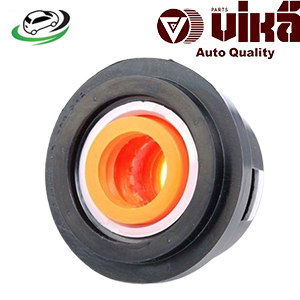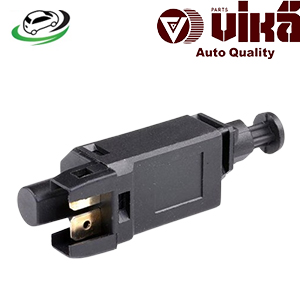-35%
Get VW Cabrio III/ Corrado/ Eurovan T4/ Golf II/III/IV/ Jetta II/III/ Passat B3/B4/ Scirocco II Brake Light Switch – 2-Pin 191945515B
A 2-pin brake light switch is an electrical switch with two terminals or pins. It is typically mounted near the brake pedal, where it makes contact or activates as soon as the brake pedal is pressed. The switch opens or closes an electrical circuit to send a signal that illuminates the rear brake lights, notifying drivers behind that the vehicle is slowing down or stopping.
In a 2-pin brake light switch, the mechanism is relatively simple:
- One pin (terminal) connects to a 12V power source.
- The other pin connects to the brake light circuit.
When the brake pedal is pressed, the switch closes the circuit, allowing current to flow to the brake lights. When the pedal is released, the switch opens the circuit, and the lights turn off.
2. Functions of a Brake Light Switch
The brake light switch serves several important functions, which directly affect the vehicle’s safety and performance:
2.1. Activating the Brake Lights
The primary function of the brake light switch is to activate the brake lights when the driver presses the brake pedal. This is a crucial safety feature, as the brake lights notify other drivers that the vehicle is decelerating or coming to a stop. Failure of this function can lead to accidents, as drivers behind may not be aware that the vehicle is slowing down.
2.2. Communicating with the Vehicle’s ECU
In modern vehicles, the brake light switch can also communicate with the vehicle’s electronic control unit (ECU). The ECU uses information from the brake switch to control other systems, such as disengaging cruise control when the brakes are applied or adjusting the anti-lock braking system (ABS) for better stability.
2.3. Disengaging Cruise Control
When a vehicle is equipped with cruise control, the brake light switch is used to disengage the system when the driver presses the brakes. Without this feature, the vehicle’s cruise control could continue operating, even when the driver intends to slow down or stop, creating a hazardous situation.
2.4. Supporting Engine Management Functions
In some advanced systems, the brake light switch is linked to the vehicle’s engine management system. The ECU may cut fuel supply to the engine when the brakes are applied to reduce power output and improve stopping efficiency.
3. Types of Brake Light Switches
While this explanation focuses on the 2-pin brake light switch, there are various types of brake light switches based on the number of terminals and their functions:
3.1. 2-Pin Brake Light Switch
This is the most basic type of brake light switch, which simply opens and closes the circuit to turn the brake lights on and off. It has two pins (terminals), one for the power input and one for the output to the brake lights.
3.2. 4-Pin Brake Light Switch
A 4-pin brake light switch is more common in vehicles with integrated electronic systems, such as cruise control and ABS. The additional pins in a 4-pin switch allow it to send signals to both the brake lights and the ECU. Two pins are used for the brake light circuit, while the other two are connected to other systems like the ABS or engine management system.
3.3. Pressure-Sensitive Brake Light Switch
Unlike the mechanical type (which is triggered by pressing the brake pedal), a pressure-sensitive brake light switch is activated by detecting hydraulic pressure in the brake lines. This type of switch is often used in older vehicles or heavy machinery.
4. Common Locations of the Brake Light Switch
The brake light switch is typically found in the following locations:
4.1. Above the Brake Pedal
In most vehicles, the brake light switch is mounted on a bracket above or behind the brake pedal. As the pedal is pressed, it activates the switch.
4.2. Brake Master Cylinder (for Pressure-Sensitive Switches)
For pressure-sensitive switches, the component is mounted directly on the brake master cylinder or within the hydraulic system. It detects changes in brake fluid pressure rather than pedal movement.
5. Signs of a Faulty Brake Light Switch
Brake light switches are generally durable but, like any mechanical or electrical component, they can fail over time. A malfunctioning brake light switch can cause several issues:
5.1. Brake Lights Not Turning On
One of the most common signs of a faulty brake light switch is when the brake lights fail to illuminate when the brake pedal is pressed. This can create a dangerous situation, as other drivers may not be aware that the vehicle is slowing down.
5.2. Brake Lights Staying On
A faulty brake light switch may cause the brake lights to stay on even when the brake pedal is not pressed. This can drain the vehicle’s battery and also confuse drivers behind, as it seems that the vehicle is constantly braking.
5.3. Cruise Control Not Disengaging
If the brake light switch is not sending the proper signal to the cruise control system, the cruise control may fail to disengage when the brakes are applied. This can result in the vehicle maintaining its speed, even when the driver intends to slow down.
5.4. ABS or Traction Control Warning Light
In vehicles where the brake light switch is connected to the ABS or traction control system, a failure of the switch may trigger warning lights on the dashboard. The ABS system may be disabled if the switch is not working correctly.
6. Causes of Brake Light Switch Failure
Several factors can contribute to brake light switch failure:
6.1. Wear and Tear
As a mechanical component, the brake light switch is subject to wear and tear over time. Continuous pressing and releasing of the brake pedal can cause the internal contacts to wear out, leading to failure.
6.2. Electrical Issues
Since the brake light switch is part of the vehicle’s electrical system, issues such as poor connections, corrosion, or blown fuses can affect its performance.
6.3. Moisture or Dirt
In some cases, moisture or dirt can get into the brake light switch, causing it to malfunction. This is particularly common in vehicles that are frequently exposed to harsh environments or excessive moisture.
7. Maintenance of Brake Light Switches
Proper maintenance of the brake light switch is essential to ensure the safe operation of the vehicle’s brake lights and other systems. Here are some maintenance tips:
7.1. Regular Inspection
Regularly check the brake lights to ensure they are functioning properly. If the brake lights are not illuminating or are staying on, inspect the brake light switch for any signs of wear or damage.
7.2. Check for Corrosion or Dirt
If the vehicle is often exposed to moisture or dirt, inspect the brake light switch and its connections for corrosion or contamination. Cleaning the switch and connections can help prevent electrical issues.
7.3. Test the Switch
To test the brake light switch, disconnect the wiring and use a multimeter to check for continuity. Press the brake pedal while testing to ensure that the switch is properly opening and closing the circuit.
7.4. Replacement
If the brake light switch is malfunctioning, it is important to replace it as soon as possible. A faulty switch can compromise the safety of the vehicle by preventing the brake lights from functioning properly.
8. Benefits of Properly Functioning Brake Light Switches
Maintaining a functional brake light switch offers several benefits, including:
8.1. Improved Safety
A properly functioning brake light switch ensures that the brake lights illuminate when the brake pedal is pressed, making other drivers aware of your intentions to slow down or stop.
8.2. Preventing Accidents
Brake lights are a critical safety feature. When they function correctly, they can help prevent rear-end collisions, especially in heavy traffic or during sudden stops.
8.3. Ensuring Proper Cruise Control Operation
For vehicles with cruise control, a working brake light switch ensures that the system disengages when the brakes are applied, preventing potential accidents caused by runaway speed.
9. Conclusion
The 2-pin brake light switch is a small but crucial component of the vehicle’s braking system, serving to activate the brake lights and ensure safe driving. While it may seem simple, its role in modern vehicles is expanded to include communication with systems like cruise control, ABS, and engine management. Recognizing the signs of failure, maintaining the switch, and ensuring it operates properly are essential for the safety and reliability of the vehicle. Regular inspection and timely replacement of a faulty brake light switch can prevent accidents, improve driving safety, and maintain the proper function of various electronic systems.
Follow us on Facebook for more parts.




Reviews
Clear filtersThere are no reviews yet.